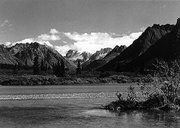Alaska Range Humid Tayga - Tundra - Meadow
Contents
Alaska Range Humid Tayga - Tundra - Meadow (Bailey)
Alaska Range, Wrangell Mountains, 61,000 mi2 (158,000 km2)
Land-surface form
The Alaska Range is a continuation of the Pacific Coast Mountains extending in an arc across the northern Pacific. The towering, glaciated peaks of the Wrangell Mountains and of the Alaska Range--which includes Mt. McKinley at 20,320 ft (6,194 m)--typify the ruggedness of the area. The only major waterways are the Susitna and upper Copper Rivers.
Climate
The Alaska Range and the Wrangell Mountains have a transitional climate of severe winters and hot, dry summers. Temperatures range from 90F to -70F (32C to -57C). Precipitation averages only 16 in (410 mm) annually.
Vegetation
Vertical vegetational zonation characterizes the Alaska Range and Wrangell Mountains, beginning with dense bottom:land stands of white spruce and cottonwood on the floodplains and low terraces of the Copper and Susitna Rivers. Above the terraces, poorly drained areas up to 1,000 ft (300 m) support stands of black spruce. Upland spruce-hardwood forests of white spruce, birch, aspen, and poplar, with an undergrowth of moss, fern, grass, and berry, extend to timberline at about 2,500-3,500 ft (800-1,100 m). Tundra systems of low shrubs and herbaceous plants form discontinuous mats among the rocks and rubble above timberline. White mountain-avens may cover entire ridges in the Alaska Range, associated with moss campion, black oxytrope, arctic sandwort, lichens, grasses, and sedges. These tundra systems stop short of the permanent ice caps on the highest peaks.
Soils
bottom:land and terrace soils of the Copper and Susitna Rivers are stratified, well-drained Entisols without pedogenic horizons. Upland hardwood forest soils are mostly shallow, well-drained Inceptisols. Permafrost is continuous on northfacing slopes, discontinuous on southfacing ones. Soils that support the moister tundra areas range from wet Inceptisols to Histosols. Alpine Inceptisols are generally shallow and poorly developed, with discontinuous or continuous permafrost.
Fauna
The Alaska Range supports large big-game populations of moose, Dall sheep, black and brown bear, wolf, caribou, and wolverine. Smaller mammals include beaver, red fox, lynx, otter, marten, squirrels, and weasel. Golden eagles, ptarmigan, ravens, and sharp-shinned hawks inhabit the uplands. Near timberline in Lake Clark National Park, Alaska Range.
Return to Ecoregions of the United States
| Disclaimer: This article is taken wholly from, or contains information that was originally published by, the United States Forest Service. Topic editors and authors for the Encyclopedia of Earth may have edited its content or added new information. The use of information from the United States Forest Service should not be construed as support for or endorsement by that organization for any new information added by EoE personnel, or for any editing of the original content. |
